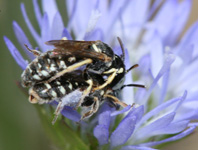Abstract
Thick-headed flies of the genus Myopa Fabricius are a common sight in early spring in Europe. Several species can be found flying among Salix catkins together with their supposed Andrena Fabricius hosts (Hymenoptera: Apidae) (John Smit observations). Despite the fact that some of these Myopa species are very common, little is known about their actual host-parasitoid associations. Only a few scattered host records can be found in the literature, most of which refer to M. testacea s.l.. Whether or not these records actually concern M. testacea (Linnaeus) is uncertain due to the confusion over the identity of several species within the M. testacea species group (Stuke & Clements 2008). Stuke (2017), in his World Catalogue of Conopids, provides all recorded host associations and distinguishes between unambiguously accepted host records and doubtful records based on three criteria: 1) the conopid has been reared from the host or a larva has been identified by DNA barcoding; 2) there is no doubt concerning the identity of the conopid species concerned, and 3) there is no doubt concerning the identity of the host species. Because the vast majority of the host records in the literature do not fulfil one or more of these criteria they are regarded as doubtful (Stuke 2017). Thus, only three host associations for the genus Myopa can be regarded as confirmed: Andrena vaga Panzer, for both M. hirsuta Stuke & Clements (Jentzsch 2009) and M. testacea (Erteld 1998, Fellendorf et al. 2004, De Meijere 1912), and the Nearctic Andrena regularis Malloch, for the Holarctic M. vicaria Walker (Miliczky & Osgood 1995). Here we report on a fourth host association for the genus Myopa, since a second instar larva of M. pellucida Robineau-Desvoidy was found in the abdomen of an Andrena nitida (Müller) female and identified using DNA barcoding.
References
Clausen, C.P. (1950) Respiratory adaptations in the immature stages of parasitic insects. Arthropoda, 1, 197-224.
De Meijere, J.H.C. (1904) Beitrage zur Kenntnis der Biologie und der systematischen Verwandschaft der Conopiden. Tijdschrift voor Entomologie, 46, 144–224.
De Meijere, J.H.C. (1912) Neue Beiträge zur Kenntnis der Conopiden XVI. Tijdschrift voor Entomologie, 67, 197–224.
Erteld, C. (1998) Untersuchungen zur Wildbienenfauna der Döberitzer Heide, Lebensgemeinshaft an einem Andrena vaga-Nistplatz und Einnischung von Anthophora bimaculata, Dasypoda hirtipes und Halictus sexcinctus (Hymenoptera: Apidae). Freie Universität Berlin, Berlin, 255 pp.
Fellendorf, M., Mohra, C. & Paxton, R.J. (2004) Devastating effects of river flooding to the ground-nesting bee, Andrena vaga (Hymenoptera: Andrenidae), and its associated fauna. Journal of Insect Conservation, 8, 311–322.
https://doi.org/10.1007/s10841-004-0514-5Ferrar, P. (1987) A guide to the Breeding Habits and Immature Stages of Diptera Cyclorrhapha. Brill, Leiden, 907 pp.
Folmer, O., Black, M., Hoeh, W., Lutz, R. & Vrijenhoek, R. (1994) DNA primers for amplification of mitochondrial cytochrome c oxidase subunit I from diverse metazoan invertebrates. Molecular Marine Biology and Biotechnology, 3 (5), 294–299.
Hebert, P.D.N., Cywinska, A. & Ball, S.L. (2003) Biological identifications through DNA barcodes. Proceedings of the Royal Society of London. Series B: Biological Sciences, 270 (1512), 313–321.
https://doi.org/10.1098/rspb.2002.2218Hebert, P.D.N., Penton, E.H., Burns, J.M., Janzen, D.H. & Hallwachs, W. (2004) Ten species in one: DNA barcoding reveals cryptic species in the neotropical skipper butterfly Astraptes fulgerator. Proceedings of the National Academy of Sciences of the United States of America, 101 (41), 14812–14817.
https://doi.org/10.1073/pnas.0406166101Jentzsch, M. (2009) Die dickkopffliegen (Insecta, Diptera: Conopidae) Sachsen-Anhalts. Naturwissenschaftliche Beiträge des Museums Dessau, 21, 61–80.
Keilin, D. (1944) Respiratory system and respiratory adaptations in larvae and pupae of Diptera. Parasitology, 36, 1–66.
https://doi.org/10.1017/S0031182000011975Malfi, R.L., Davis, S.E. & Roulston, T.H. (2014) Parasitoid fly induces manipulative grave-digging behaviour differentially across its bumblebee hosts. Animal behaviour, 92, 213–220.
https://doi.org/10.1016/j.anbehav.2014.04.005Miliczky, E.R. & Osgood, E.A. (1995) Bionomics of Andrena (Melandrena) vicina Smith in Maine and Washington, with new parasite records for A. (M.) regularis Malloch and a review of Melandrena biology. Journal of the Kansas Entomological Society, 68, 51–66.
Nieuwenhuijsen, H. (2009) Andrena barbilabiris, een mogelijke gastheer van de blaaskopvlieg Myopa tessellatipennis. Bzzz, 30, 53–54.
Schmid-Hempel, P., Mueller, C., Schmid-Hempel, R. & Shykoff, J.A. (1990) Frequency and ecological correlates of parasitism by conopid flies (Conopidae, Diptera) in populations of bumblebees. Insectes Sociaux, 37, 14–30.
https://doi.org/10.1007/BF02223812Schmid-Hempel, P. & Stauffer, H.P. (1998) Parasites and flower choice of bumblebees. Animal behavior, 55, 819–825.
https://doi.org/10.1006/anbe.1997.0661Simon, C., Frati, F., Beckenbach, A., Crespi, B., Liu, H. & Flook, P. (1994) Evolution, weighting, and phylogenetic utility of mitochondrial gene sequences and a compilation of conserved polymerase chain reaction primers. Annals of the Entomological Society of America, 87, 651–701.
https://doi.org/10.1093/aesa/87.6.651Stuke, J.H. (2017) Conopidae (Diptera). World Catalogue of Insects, 15, 1–354.
Stuke, J.H. & Clements, D.K. (2008) Revision of the Myopa testacea species-group in the Palaearctic region (Diptera: Conopidae). Zootaxa, 1713, 1–26.

